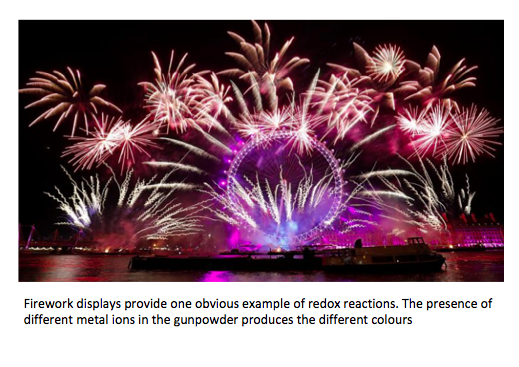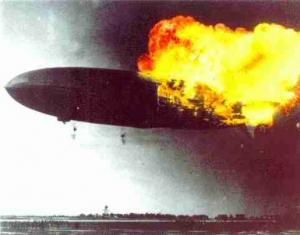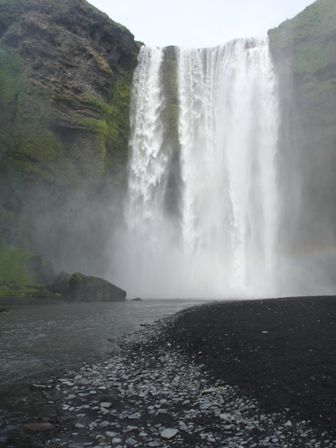9.1 Oxidation & reduction
Written specifically for students to provide help and support for the IB Diploma chemistry programme this page provides full coverage of the syllabus content of Topic 9.1 Oxidation & reduction. It encourages you to think critically and provides many questions with full worked answers so that you can monitor and improve your knowledge and understanding.


 Learning outcomes
Learning outcomes
 After studying this topic you should be able to:
After studying this topic you should be able to:
Understand
- There are different ways of considering oxidation and reduction. It can be considered in terms of gain or loss of oxygen, loss or gain of hydrogen, transfer of electrons or change in oxidation state.
Oxidizing agents are reduced and reducing agents are oxidized.
Transition metals and most non-metals can have variable oxidation numbers and oxidation states.
Metals are ranked according to the ease with which they undergo oxidation in the activity series.
Biochemical oxygen demand (BOD), which is used as a measure of the degree of pollution in a water sample, can be measured by the Winkler method.
Apply your knowledge to:
- Deduce the oxidation states of atoms in an ion or a compound.
- Deduce the name of a transition metal compound from a given formula.
- Apply oxidation numbers using Roman numerals.
- Identify the oxidizing and reducing agents and the species that are oxidized and reduced in redox reactions.
- Deduce the balanced equation for a redox reaction using half-equations in acidic or neutral solutions.
- Deduce the feasibility of a redox reaction from the activity series or reaction data.
- Solve problems involving redox titrations.
- Apply the Winkler Method to calculate BOD.
Relationships & vocabulary
Nature of science
Scientists often broaden similarities to general principles. The way in which the definition of redox has changed from one involving just oxygen and hydrogen to one involving the transfer of electrons and a change in oxidation states is a good example of this.
International-mindedness
The United Nations recognises access to a supply of clean drinking water as a fundamental human right. Even so, over one billion people in the world are thought to lack this basic provision. Oxidizing agents, such as chlorine or ozone, are commonly used to disinfect water by killing microbial pathogens.
For more examples and links to International mindedness, Theory of knowledge, utilization etc. see separate page which covers all of Topics 9 & 19: Redox processes.
Vocabulary
| oxidation | reduction | redox |
| oxidation state | oxidation number | Roman numerals |
Learning slides
You can use this slide gallery for learning or for reviewing concepts and information. It covers all the key points in the syllabus for this sub-topic.
Something to think about
1. Definitions of oxidation
In the syllabus it states "Oxidation and reduction can be considered in terms of oxygen gain/hydrogen loss, electron transfer or change in oxidation number". It is worth examining this statement.
The combustion of hydrogen that occurred during the Hindenburg zeppelin airship disaster in 1937 killed 35 people. It was clearly an example of oxidation as oxygen added to hydrogen to form water.

In fact two of the classic examples of oxidation are the combustion of hydrogen to form water and the combustion of carbon to form carbon dioxide. Much of the energy we use in the World comes from burning a combination of these two elements in the form of hydrocarbons. Many text books define oxidation in terms of electron loss and reduction in terms of electron gain but are any electrons actually transferred when hydrogen burns in oxygen to form water or when carbon or hydrocarbons burn?

In all of these examples it is obvious that the hydrogen and the carbon are oxidized as oxygen is added and yet in none of these cases does the substance being oxidized lose any electrons. You already know from sub-topic 4.2 Covalent bonding that each hydrogen atom shares two electrons in hydrogen gas, hydrocarbons and in water (the oxidized product). Similarly each carbon atom shares eight electrons in graphite and eight electrons in hydrocarbons and in carbon dioxide, the oxidized product, it still shares eight electrons. You should understand that although the loss of electrons is always oxidation the converse is not always true. You can read more about this in the TOK section in Topics 9 & 19.
2. Why is lithium above potassium in the activity series?
The activity series for students to use is given in Section 25 of the IB data booklet. Students and teachers know that potassium reacts more vigorously than lithium when it is added to water. so why is lithium listed above potassium in the activity series? For a full explanation of this and how the activities series for metals differs from the reactivity series for metals see the separate page on Understanding the activity series.
3. A practical example.
The syllabus includes one very specific environmental application of redox processes - the determination of dissolved oxygen in water. In fact it goes slightly further than this as it relates the amount of dissolved oxygen to the biochemical oxygen demand (BOD). Although this provides a good example to test whether you can apply redox equations when performing calculations it is rather out of date as modern methods to determine BOD bypass this procedure and simply use an oxygen probe (sensor) connected to a data logger (see other resources 3 below).
 The fact that oxygen dissolves in water is essential for aquatic life. The solubility of oxygen in water depends on several factors with the two most important ones being the salinity of the water and the temperature – an increase in both lowers the amount of dissolved oxygen. The amount of dissolved oxygen present also depends upon the amount of algae or organic material in the water both of which use up oxygen. Biochemical oxygen demand (BOD) is a measure of the amount of dissolved oxygen required to decompose organic matter in water at a fixed temperature over a certain time period (usually quoted at 20 oC over five days). It is a useful measure to determine the degree of pollution of a water sample. Water with a BOD of more than 5 ppm is generally considered polluted. Even water with a high BOD can still recover and be reoxygenated if the water is fast flowing.
The fact that oxygen dissolves in water is essential for aquatic life. The solubility of oxygen in water depends on several factors with the two most important ones being the salinity of the water and the temperature – an increase in both lowers the amount of dissolved oxygen. The amount of dissolved oxygen present also depends upon the amount of algae or organic material in the water both of which use up oxygen. Biochemical oxygen demand (BOD) is a measure of the amount of dissolved oxygen required to decompose organic matter in water at a fixed temperature over a certain time period (usually quoted at 20 oC over five days). It is a useful measure to determine the degree of pollution of a water sample. Water with a BOD of more than 5 ppm is generally considered polluted. Even water with a high BOD can still recover and be reoxygenated if the water is fast flowing.
The amount of dissolved oxygen is traditionally determined using the Winkler method. This was devised by the Hungarian Lajos Winkler (1863-1939) for his Ph.D. thesis in 1888. Excess manganese(II) sulfate and hydroxide ions are added to a known volume of the water sample. The dissolved oxygen oxidises the manganese(II) ions to give a brown precipitate (usually considered to be a hydrated form of manganese(IV) oxide). In the presence of acid this then oxidises iodide ions into iodine and is itself reduced back to manganese(II). The iodine produced is titrated with standard sodium thiosulfate solution using starch as the indicator.
2Mn2+(aq) + O2(aq) + 4OH− (aq) → 2MnO2(s) + 2H2O(l)
(Note that some texts give the formula of the Mn(IV) product as MnO(OH)2 but this does not affect the overall stoichiometry.)
MnO2(s) + 2I−(aq) + 4H+(aq)→ Mn2+(aq) + I2(aq) + 2H2O(l)
2S2O32−(aq) + I2(aq) → S4O62−(aq) + 2I−(aq)
By following the stoichiometry you can see that one mole of dissolved oxygen is equivalent to four moles of thiosulfate ions.
Test your understanding of this topic
(Note that your teacher may have restricted your access to some or all of these questions and worked answers if they are going to use them as a class test or set them as an assignment.)
For ten 'quiz' multiple choice questions with the answers explained see MC test: Oxidation & reduction.
For three different sets of short-answer questions see Oxidation & reduction questions (1), Oxidation & reduction questions (2) and Oxidation & reduction questions (3).
More resources
1. A video that shows how oxidation states change across the periodic table (although the terms oxidation states and numbers are interchanged at times).
2. Deducing whether an element has been oxidized or reduced during a redox reaction using oxidation states (note that the video uses oxidation numbers rather than states as this was from the old programme).
3. The old fashioned Winkler method may be good but it is much easier these days to use a dissolved oxygen probe. The video shows how easy it is to use the Nexsens dissolved oxygen sensor.

 IB Docs (2) Team
IB Docs (2) Team 
































